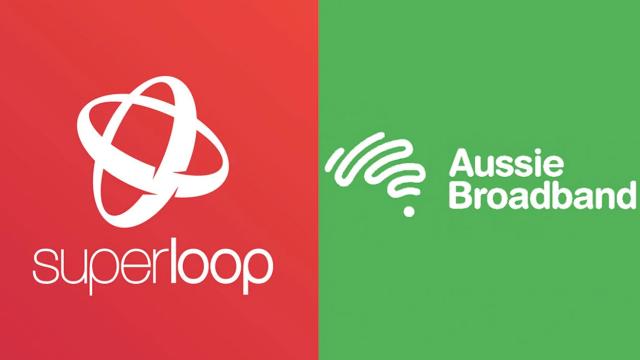If you’re looking for an alternative to the bigger names in NBN, Aussie Broadband and Superloop are two providers that should be on your radar.
While there are differences between the two, they share a few excellent traits: solid peak hour speeds, local support, and contract-free plans with no setup or exit fees. Here’s how they compare.
Who are they?
Both Aussie Broadband and Superloop are smaller NBN providers that have made an impact on the market.
Aussie Broadband has been around for over a decade, and made a name for itself thanks to a combination of consistently high evening speeds and excellent local support.
Superloop has been selling NBN plans for over three years now and acquired Exetel last year. The telco has also been in the business of providing wholesale services to other providers for over half a decade. As such, Superloop owns a lot of the infrastructure that other telcos typically rent.
Both Aussie Broadband and Superloop have connectivity at all 121 NBN Points of Interconnect. This means they have full control over their network and capacity.
Speeds
Both Aussie Broadband and Superloop offer solid evening speeds across the board, but Aussie has a slight edge on most tiers.
| NBN 1000 | NBN 250 | NBN 100 | NBN 50 | |
| Aussie Broadband | 600Mbps | 244Mbps | 97Mbps | 48Mbps |
| Superloop | 500Mbps | 240Mbps | 95Mbps | 48Mbps |
Both Superloop and Aussie Broadband back up their speed claims with bandwidth graphs. These show how much capacity the telcos have purchased on their network, versus how much capacity their customers are using.
Unlimited NBN 50 plans
On NBN 50 plans, Superloop and Aussie Broadband report identical typical evening speeds of 48Mbps.
With Superloop, you’ll pay $53.95 per month for your first six months, and $69.95 per month thereafter. On Aussie, you’re looking at $79 per month.
All Superloop and Aussie Broadband NBN plans are free from contracts and setup fees.
Unlimited NBN 100 plans
Aussie Broadband is a hair faster than Superloop when it comes to NBN 100 plans, reporting typical evening speeds of 97Mbps. Superloop reports 95Mbps.
Superloop is the more affordable of the pair, however. With Superloop, you’re looking at $68.95 per month for your first six months and $84.95 per month thereafter. On Aussie, you’ll pay $99 per month.
Superloop and Aussie Broadband are two of the few providers that also offer NBN 100 / 40 plans. Opting for an NBN 100 / 40 plan doubles your upload speed to 40Mbps, up from the standard 20Mbps most NBN 100 plans come with.
On Superloop, you’ll pay $77.95 per month for your first six months, and $94.95 per month thereafter. On Aussie, you’re up for $109 per month if you want faster upload speeds on your NBN 100 plan.
Unlimited NBN 250 plans
It’s a similar story with NBN 250 plans. On Superloop you’ll pay $99.95 per month for your first six months, and then $119.95 per month. On Aussie Broadband, you’re looking at $129 per month.
Evening speeds are pretty similar, with Aussie reporting 244Mbps and Supes 240Mbps.
NBN 250 plans are only available to FTTP and HFC premises.
If you need faster upload speeds, Aussie Broadband also has an NBN 250 plan with 100Mbps up. That’s four times faster than a standard NBN 250 plan. It will set you back $209 per month, however, and is only available to FTTP addresses.
NBN 1000 plans
If you’re looking at the fastest NBN around (and won the NBN connection type lottery), both Aussie and Superloop have NBN 1000 plans.
Aussie Broadband charges $149 per month, and reports typical evening speeds of 600Mbps.
Superloop will set you back $119.95 for your first six months and $139.95 per month thereafter. This plan is a limit more limited, however. While Supes reports typical evening speeds of 500Mbps, the plan itself is capped at 500Mbps. You’ll never see faster speeds. The plan also has a 3TB allowance, and if you go over this, you’ll be restricted to speeds of 100Mbps for the remainder of your billing month.
NBN 1000 plans are available to FTTP premises, and 95% of HFC premises.
Support
Both Aussie Broadband and Superloop offer local support, but Aussie Broadband is open for longer hours.
If you want to call Aussie, you can do so between 8:00 am and midnight, every single day other than Christmas and Good Friday. Superloop’s support hours are 7.30 am to 6.30 pm on weekdays, 10:00 am to 6:00 pm on weekends, and 10:00 am to 6:00 pm on public holidays.
From personal experience, I’ve found support staff on both telcos incredibly helpful. Wait times were shorter on Aussie Broadband, but I’ve not made enough calls to either telco to say that this is always the case.
Other NBN plans
If neither Aussie Broadband nor Superloop seems right for you, here’s a selection of popular NBN 50 plans from other providers:
This article has been updated since its original publish date.

Leave a Reply